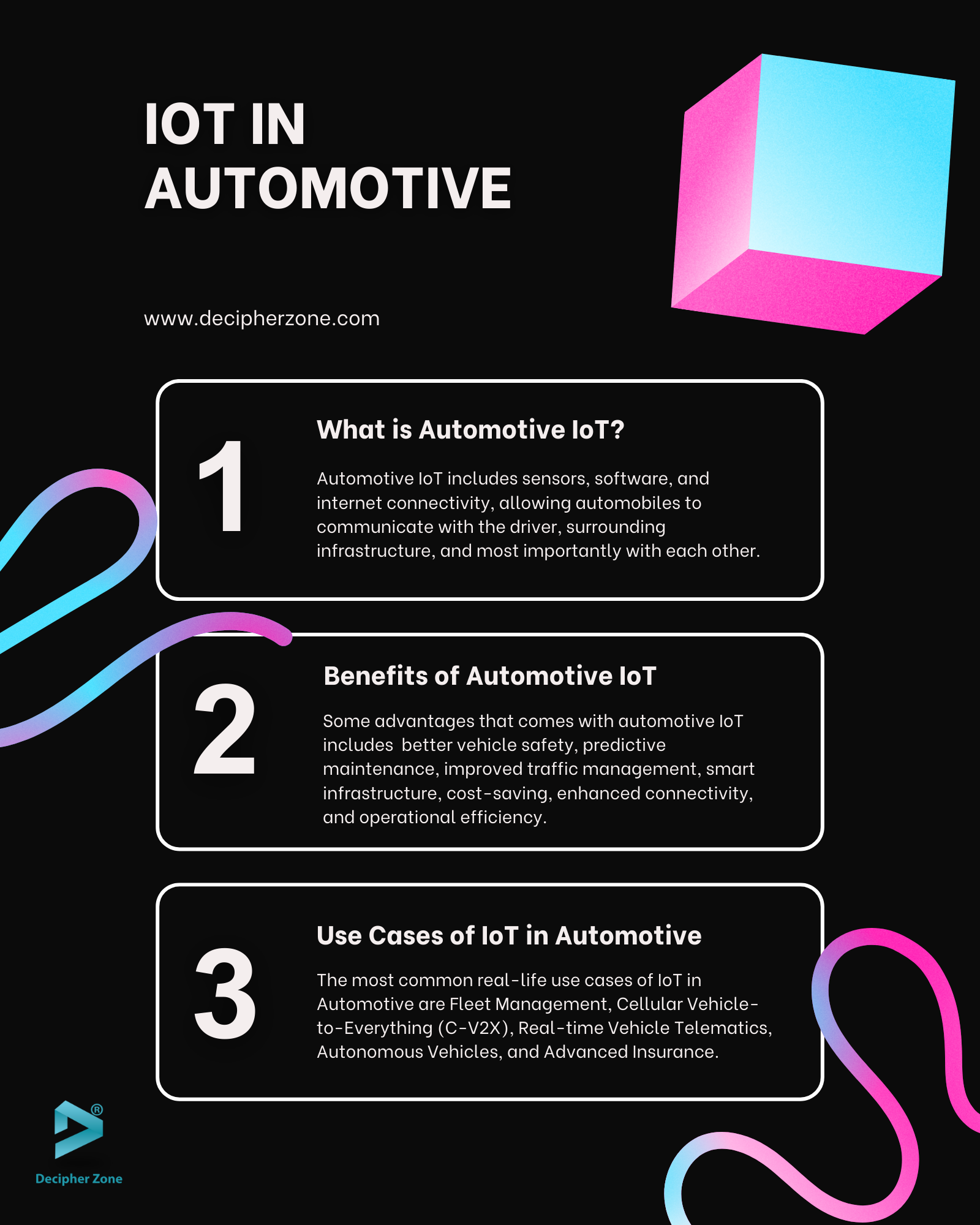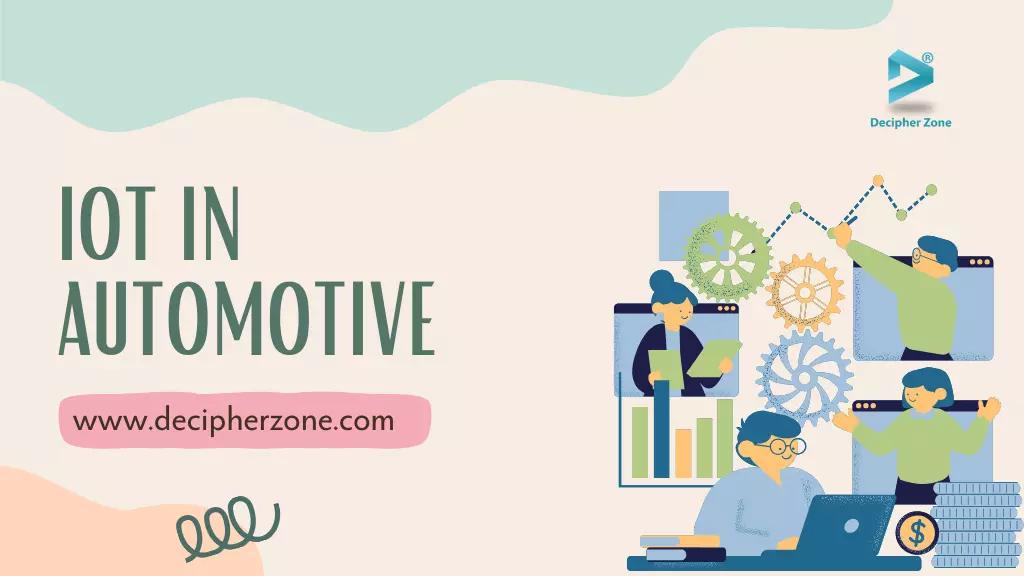What are the top use cases and benefits of IoT in the automotive industry? In today's technologically advanced world, the Internet of Things (IoT) has brought about a monumental shift in how industries operate. It has enabled the creation of a connected infrastructure and smart cars, paving the way for an efficient, safe, and intelligent landscape.
Intending to stay competitive and meet customer expectations, automotive manufacturers are increasingly turning to IoT to leverage its power and optimize their operations.
This has resulted in a significant transformation in the way cars are designed, built, and driven, making the automotive industry one of the most exciting areas of innovation.
IoT in the Automotive Industry: Use Cases, Benefits
Planning to integrate IoT in your automotive business? This blog will help you understand everything you need to know about automotive IoT, its benefits, and use cases.
What is Automotive IoT?
As the name suggests automotive IoT describes the IoT integration into automobiles. It is done to improve the connectivity and functionality of smart automobiles.
Automotive IoT includes sensors, software, and internet connectivity, allowing automobiles to communicate with the driver, surrounding infrastructure, and most importantly with each other.
Automotive IoT can be used to improve safety, efficiency, and convenience in automobiles, as well as enable new services and business models in the automotive industry.
Some examples of Automotive IoT applications include connected cars, autonomous vehicles, and smart traffic management systems.
Read More: What is Software Development?
Benefits of IoT in the Automotive Industry
Some of the benefits of using IoT in the automotive industry are as follows:
-
Better Vehicle Safety
-
Predictive Maintenance
-
Improved Traffic Management
-
Smart Infrastructure
-
Enhanced Connectivity
-
Cost-Saving
-
Operational Efficiency
-
Data-Driven Insights
Better Vehicle Safety: Integrating cameras and sensors that are IoT enables potential collision detection and triggers automated responses like emergency braking or distress signal transmission to emergency services.
Read More: Most Popular Types of Software Development
Predictive Maintenance: IoT-enabled vehicles share diagnostic data in real-time with service centers to minimize downtime and empower proactive maintenance, resulting in the longevity and reliability of the automobile.
Improved Traffic Management: Another incredible benefit that Automotive IoT offers is traffic management. IoT vehicles do so by communicating with traffic infrastructure and optimizing signal timings based on real-time traffic status to reduce congestion. It also allows drivers to opt for the most efficient route to reach their destination swiftly.
Smart Infrastructure: Apart from improved traffic management and vehicle safety, infrastructures and roads also play a pivotal role in the automobile sector. That being said, Smart sensors enable drivers to experience safe, hassle-free parking and a better driving experience. Furthermore, IoT sensors provide data to develop sustainable urban planning strategies.
Read More: How to Choose a Software Development Company
Enhanced Connectivity: Smart transport systems and vehicles can connect through the Internet of Things (IoT) to provide advanced infotainment systems. These systems offer real-time navigation, streaming services, and information sharing. They help manage traffic flow, minimize accident risks, and provide relevant information like speed, route, and location.
Cost-Saving: Through optimized route planning, proactive maintenance, and ideal time reduction, automotive IoT promotes better fuel efficiency and minimized downtime, leading to cost-saving.
Read More: Benefits of Hiring a Software Development Company
Operational Efficiency: Automotive IoT facilitates real-time fleet monitoring and supply chain tracking that allows businesses to improve inventory management, reduce fuel consumption, optimize routes, and streamline production processes, enhancing overall operational efficiency.
Data-Driven Insights: Data generated by automotive IoT provides valuable insights for businesses, policymakers, and manufacturers, allowing them to make informed decisions for continuous automotive ecosystem improvement.
Read More: Software Development Challenges and Solutions

Top 5 Use Cases of IoT in the Automotive Industry
Automotive IoT has unlocked several opportunities and possibilities in the industry. Some of the major use cases of IoT in automotive are as follows:
-
Fleet Management
-
Cellular Vehicle-to-Everything (C-V2X)
-
Real-time Vehicle Telematics
-
Autonomous Vehicles
-
Advanced Insurance
Read More: Transportation and Logistics Software Development
1. Fleet Management
Automotive IoT helps with fleet management by allowing fleet operators to track, monitor, and manage their commercial vehicles (fleets). These vehicles get integrated with IoT-enabled sensors that share statistics on fuel consumption, route optimization, maintenance scheduling, driver performance and health, idle alarms, drowsiness detection, etc. to improve fleet efficiency and trip planning while reducing overall operational cost.
2. Cellular Vehicle-to-Everything (C-V2X)
It is a unified connectivity platform that is designed to connect vehicles-to-vehicles (V2V), Vehicles-to-Infrastructure (V2I), Vehicle-to-Network (V2N), and Vehicle-to-Pedestrians (V2P).
This automotive IoT platform allows faster transmission of data, enhanced vehicle communication, and traffic flow management to prevent accidents, avoid traffic congestions, facilitate easy emergency vehicle movement, track public transit arrival timings, alert drivers about weather changes, and more.
3. Real-time Vehicle Telematics
Integrating IoT-enabled telematics devices into vehicles, businesses can gain real-time updates on vehicle status and driver’s health by tracking vehicle position, movements, behavior, and conditions. It also allows remote control over the vehicle’s speed, accident notifications to emergency responders, etc.
Read More: CAD Software Development - Features, Benefits and Cost
4. Autonomous Vehicles
Autonomous vehicles have become a new trend in the automotive industry. Backed by IoT, these semi-autonomous vehicles use C-V2X sensors and devices that provide enormous amounts of data regarding road conditions, traffic, navigation, etc. to help these vehicles make real-time, informed decisions, reduce the load from drivers, and avoid accidents.
5. Advanced Insurance
IoT technology is revolutionizing the insurance industry by allowing for personalized insurance premiums. Usage-Based Insurance (UBI) programs use devices like odometers and in-vehicle telematics to collect data on driving style, car condition, and location.
Insurance companies use this data to set premiums based on driving skills. Some companies even offer app-based programs that don't require any physical devices, only GPS data.
Read More: Top 12 Skills A Software Developer Should Have in 2024
Conclusion
The confluence of automotive with IoT technology is bound to reshape the industry by enhancing driving innovations and experience in remarkable ways. It will not only improve traffic management and automobile systems but also provide enhanced safety. IoT in automotive is bringing out new possibilities on how a future vehicle will become more than just a mode of transportation contributing to a smarter, more efficient, and safer world.
So, if you are also interested in developing IoT software to enhance the automobile experience for your user, then get in touch with our experts who are well-versed with the latest technologies. They will help you achieve your goals effortlessly without putting a hole in your pocket.
Read More: What is Cyber Resilience: Components, Benefits and Threats
FAQs: IoT in Automotive: Use Cases, Benefits
What is automotive IoT?
Automotive IoT is the integration of the Internet of Things (IoT) into cars. The main goal is to improve the connectivity and functionality of smart cars. Automotive IoT involves using sensors, software, and internet connectivity to enable cars to communicate with the driver, surrounding infrastructure, and other cars.
What is the role of IoT in autonomous vehicles?
IoT in autonomous vehicles enables seamless operation and integration of self-driving vehicles while improving their safety and functionality through sensor integration, real-time data processing, vehicular communication networks, navigation and route planning, cyber security, remote monitoring and diagnostics, fleet management, and safety systems.
What are the benefits of automotive IoT?
Some of the benefits that automotive IoT provides include better vehicle safety, predictive maintenance, improved traffic management, smart infrastructure, cost-saving, enhanced connectivity, and operational efficiency.

